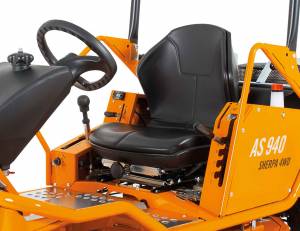Safety is the top priority: Tips from AS-Motor experts for mowing on slopes
Mowing steep slopes is a demanding task for both man and machine. The experts of AS-Motor, a manufacturer of high grass mowing equipment, outline tips and basic rules that not only facilitate slope mowing but improve operator safety.
Mowers’ operating manuals are mandatory reading. They contain information regarding the safe and intended use of each device, and provide assistance for the fundamental decision as to whether a specific mower is suitable for use on certain types of terrain. When mowing slopes, for example, information concerning stability diagonal to the slope deserves special attention and should always be complied with. If the details cited here deviate from the information in the operating manual, the information in the operating manual always takes precedence.
Before we get started
Increased caution is required on steep slopes as there is danger of injury if the operator slips or the mower tips over. Downhill tasks are more difficult to master than uphill tasks – even if you can easily make it up the slope with your mower, things can become problematic on the way down.
Thus, the downhill path must be thought through from the outset. At certain gradients you should only work with mowers that have both propulsion and a brake. AS-Motor devices are equipped with a safety brake, meaning that release of the drive lever automatically activates the parking brake, bringing the mower to a standstill. Limited-slip differential is not a luxury but rather a considerable safety feature that limits the speed of downhill travel.
Tip 1: Check the mower and the terrain
Certain ground rules apply whether the area is steep or level: for example, a visual inspection should always take place before starting a mower. Check the blade, protective cloths or plates, drive and fastening parts, as well as cables and cable connections for faultless condition. Also check your work area for foreign objects before starting to mow. Remove rocks, sticks, wires and other objects that could be ejected from the mower deck. Holes, stones, roots, drainage ditches, etc. can cause imbalance or collision with the blades, especially if the mower is not equipped with a blade clutch. The operator must note these points and mow at an adequate distance from them.
Tip 2: Gradient and ground conditions
The gradient and ground conditions are important when mowing slopes. Today smart phone apps can easily determine the gradient – at a tip-over limit of 21 degrees, who can precisely assess whether the inclination is 19 or 23 degrees by eye? In any case, ride-on mowers should ideally be equipped with tilt meters.
Moreover, it is important to assess the ground condition when mowing slopes. Minimal ground cover and loose or wet soil increases the danger of slipping. If a mower starts to slip or tip over, immediately let go of the mower and do not attempt to stop it or keep hold of it. Injury should be avoided at all costs.
Tip 3: Mowing extreme slopes
Extreme slopes start at inclines of 40 degrees. Walking becomes difficult on these slopes, let alone mowing tasks. Certain accessories such as agricultural tread and/or twin tyres, spikes and steel wheels improve traction while oscillating crawler tracks that move in proportion to each other are particularly effective at maintaining ground contact on extreme slopes.
Operating manuals specify the engine manufacturer’s precise gradient limits. The lubricating film of 4-stroke engines can tear on extreme slopes, causing engine damage. This risk does not exist for 2-stroke engines which is why they are ideally suited for tasks on extreme slopes.
Tip 4: Refueling
A basic rule for mowing on a slope is: fill it up. If the mower does not have a fuel pump, petrol will no longer reach the engine at certain gradients which can lead to the engine stopping on its own. Tapered fuel tanks are better suited for inclined surfaces. When the level of liquid drops, petrol will no longer reach the fuel tap in tanks that are flat at the bottom. As a rule, AS-Motor devices are equipped with a fuel reserve which makes it possible to safely drive off the slope and refuel.
The mower must be on a level surface when refueling. Furthermore the engine must adequately cool down so that spilled fuel cannot spontaneously ignite. The operating manual specifies how long it takes for the engine to cool down. Since excess pressure can occur in the tank, the tank cap must be opened slowly and carefully. Mechanical brakes that work in the instance of engine failure are important safety features, especially for ride-on mowers.
A device’s operating manual contains a lot of worthwhile information beyond these tips. This information can be accessed at www.as-motor.com. In addition, you can watch Product Safety Videos on AS-Motor’s YouTube channel.


